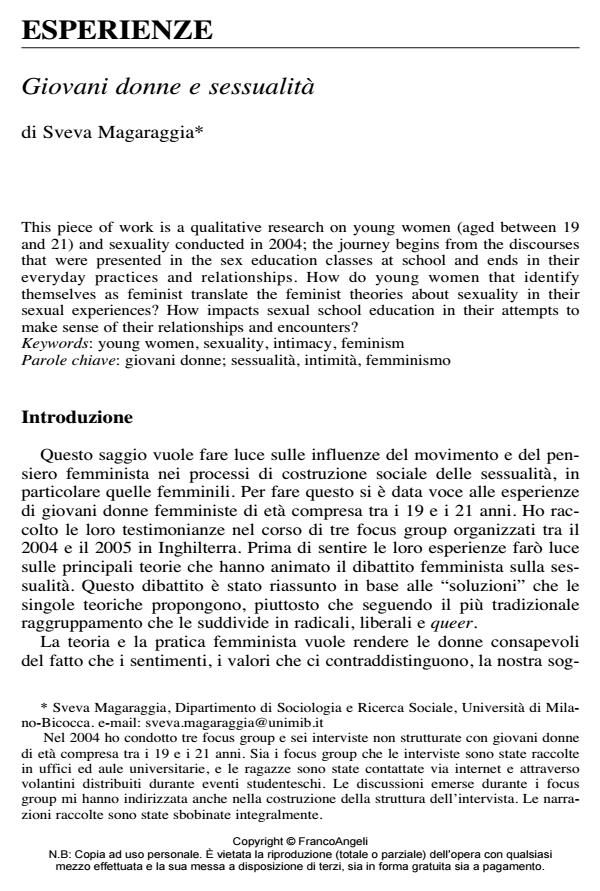Giovani donne e sessualità
Titolo Rivista SALUTE E SOCIETÀ
Autori/Curatori Sveva Magaraggia
Anno di pubblicazione 2013 Fascicolo 2013/2 Lingua Italiano
Numero pagine 15 P. 115-129 Dimensione file 112 KB
DOI 10.3280/SES2013-002007
Il DOI è il codice a barre della proprietà intellettuale: per saperne di più
clicca qui
Qui sotto puoi vedere in anteprima la prima pagina di questo articolo.
Se questo articolo ti interessa, lo puoi acquistare (e scaricare in formato pdf) seguendo le facili indicazioni per acquistare il download credit. Acquista Download Credits per scaricare questo Articolo in formato PDF

FrancoAngeli è membro della Publishers International Linking Association, Inc (PILA)associazione indipendente e non profit per facilitare (attraverso i servizi tecnologici implementati da CrossRef.org) l’accesso degli studiosi ai contenuti digitali nelle pubblicazioni professionali e scientifiche
This piece of work is a qualitative research on young women (aged between 19 and 21) and sexuality conducted in 2004; the journey begins from the discourses that were presented in the sex education classes at school and ends in their everyday practices and relationships. How do young women that identify themselves as feminist translate the feminist theories about sexuality in their sexual experiences? How impacts sexual school education in their attempts to make sense of their relationships and encounters?;
Keywords:Giovani donne; sessualità, intimità, femminismo
- Holland J., Ramazanoglu C., Sharpe S. e Thomson R. (1998). The Male in the Head. Young People, Heterosexuality and Power. London: The Tufnell Press
- Allen L. (2004). Beyond the birds and the bees: Constituting a discourse of erotics in sexuality education. Gender and Education, 16 (2): 151-167 DOI: 10.1080/09540250310001690555
- Beasley C. (2013). Salute sessuale, educazione sessuale e violenza. In: Magaraggia S. e Cherubini, D., a cura di, Le radici della violenza maschile contro le donne. Torino: Utet (in corso di pubblicazione).
- Butler J. (1993). Bodies that Matter. On the Discursive Limits of ‘Sex’. London: Routledge
- Butler J. (1994). Against proper objects. Differences: A Journal of Feminist Cultural Studies, 6 (2): 1-26.
- Butler J. (1999). Revisiting bodies and pleasures. Theory, Culture & Society 16(2): 11-20 DOI: 10.1177/02632769922050520
- Cartledge S. e Ryan J. (1983). Sex and Love. New Thoughts on Old Contradictions. London: Women’s Press
- Duncan S., Edwards R. e Alexander C. (2010). Teenage Parenthood: What’s the Problem? London: Tufnell Press.
- Eisenstein H. (1984). Contemporary Feminist Thought. London: Unwin
- Fine M. (1988). Sexuality, schooling, and adolescent females: the missing discourse of desire. Harvard Educational Review, 58 (1): 29-53.
- Firestone S. (1975). The Dialectic of Sex: the Case for Feminist Revolution. New York: Morrow
- Gerhard J. (1996). The personal is still political: the legacy of 1970s feminism. In: Maglin N.B. e Perry D.M., a cura di, Bad Girls, Good Girls: Women, Sex, and Power in the Nineties. New Brunswick: Rutgers University Press
- Griffiths M. (1995). Feminism and the Self. The Web of Identity. London: Routledge, DOI: 10.4324/9780203204245
- Haraway D. (1985). A manifesto for cyborgs: science, technology and socialist feminism in the 1980’s. Socialist Review, 80: 65-108
- Irigaray L. (1985). This Sex Which is Not One. Ithaca: Cornell University Press
- Jackson S. (1999). Feminist sociology and sociological feminism: recovering the social in feminist thought. Sociological Research Online, 4 (3), testo disponibile ai sito: www.socresonline.org.uk/4/3/jackson.html.
- Namaste V. (2009). Undoing theory: the transgender question and the epistemic violence of Anglo-American feminist theory. Hypatia: Journal of Feminist Philosophy, 24 (3): 11-32 DOI: 10.1111/j.1527-2001.2009.01043.x
- Katz J. (1995). The Invention of Heterosexuality. New York: Dutton
- Kemp S. e Squires J. (1997). Feminisms. Oxford: Oxford University Press
- Kitzinger C. e Frith H. (1999) Just say no? The use of conversation analysis in developing a feminist perspective on sexual refusal. Discourse & Society, 10 (3): 293-316. DOI: 10.1177/0957926599010003002
- Magaraggia S. e Cherubini D., a cura di (2013). Le radici della violenza maschile contro le donne. Torino: Utet (in corso di pubblicazione).
- Phillips L. (2000). Flirting with Danger: Young Women’s Reflections On Sexuality and Domination. New York: New York University Press
- Rich A. (1980). Compulsory Heterosexuality and Lesbian Existence. London: Onlywomen Press
- Richardson D. (2000). Rethinking Sexuality. London: Sage
- Rosina A. (2011). I giovani e la famiglia. In: Ruspini E., a cura di, Studiare la famiglia che cambia. Roma: Carocci: 31-56.
- Rubin G. (1975). The traffic in women: notes on the political economy of sex. In: Reiter R.R., a cura di, Toward an Anthropology of Women. New York: Monthly Review Press: 157-210.
- Taylor P. e Keeter S., a cura di (2010). Millennials: A Portrait of Generation Next. Confident, Connected, Open to Change. Washington DC: Pew Research Center, testo disponibile al sito: www.pewsocialtrends.org/files/2010/10/ millennials-confident-connected-open-to-change.pdf
- Ussher J. (1994). Theorising female sexuality: social constructionist and poststructuralist accounts. In: Choi P. e Nicholson P., a cura di, Female Sexuality. Hertfordshire: Harvester Wheatsheaf: 149-173.
- ‘The pictures I really dislike are those where the girls are naked!’ Postfeminist norms of female sexual embodiment in contemporary Italian digital culture Arianna Mainardi, in Modern Italy /2018 pp.187
DOI: 10.1017/mit.2018.6
Sveva Magaraggia, Giovani donne e sessualità in "SALUTE E SOCIETÀ" 2/2013, pp 115-129, DOI: 10.3280/SES2013-002007